Monday, May 30 2016
After holding again at its very strong 204.0 support level, the SPY "Blasted-Off" again last Tuesday (5/24/16), heading for its all-time closing high at 213.5 (the intraday high is 214.0). If the market breaks above 214.0 (approx. 2140 on the S&P 500 Index), with some degree of strength, we could easily get a 5-10% rally thereafter.
Two things stand in the way of this:
- one is the Fed (surprise, surprise) and
- the other is the SPY's extremely strong resistance at 214.0. This is a very tough one to call, but we have high confidence that MIPS will pick up the trend quickly.
Stay tuned...
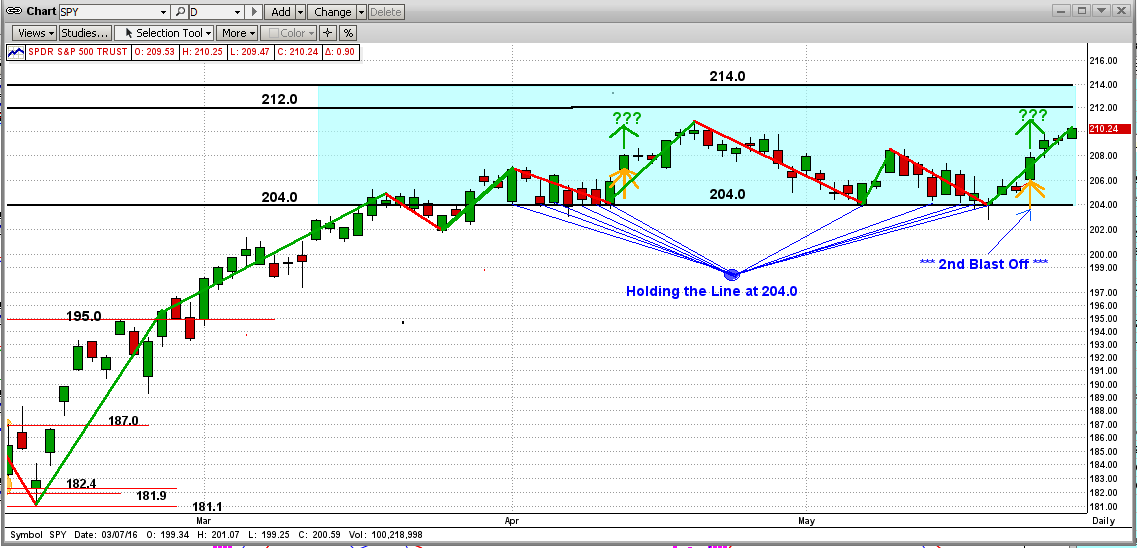
Thursday, May 19 2016
The Fed's big mouth Yellin is yelling and the market is running for the hills. On economic news that should have been good for the market, the Fed once again managed to make it bad news by insinuating the re-start of rate hikes and possibly even more quantitative easing (which would become QE4).
Since the beginning of 2016, the Bulls have fought off all market drops, and the S&P 500 is up for the year. In the last 2 months alone, the Bulls have offered very strong support at 204.0 on the SPY. To be exact, the SPY has amazingly hit and bounced up off of its 204.0 downside support level 12 times in the last two months (see graph below)!!!
We believe that the SPY "break-out" from 204.0 will be volatile and could lead to a major move up or down (i.e., new highs or a market crash). Or course, none of us know for sure which way the market will go from here, but we believe that MIPS will figure it out quickly. Stay tuned and watch closely !!!
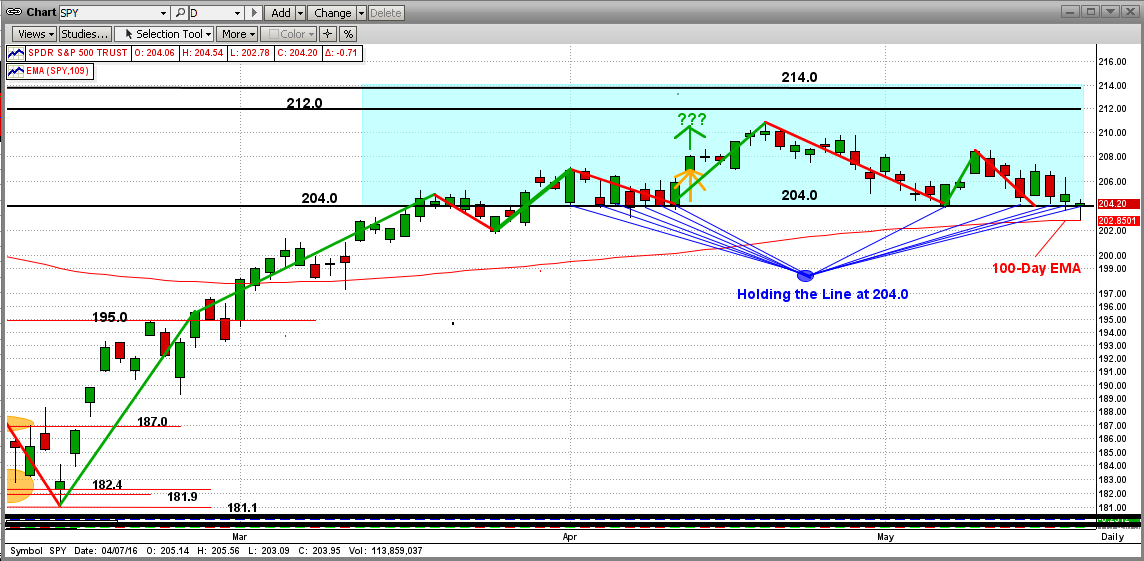
Sunday, May 15 2016
Right above the 2nd graph below, we just added this:
Note: MIPS does not get "fooled" by the lag mentioned above and has called (and should continue to call) the drops/recoveries long before a single indicator like PRICE would. In 2008, MIPS was up over 50% !!!
-------------------------------------------------------------------------------------------------------------------------------
MIPS Members:
We are all wondering where this market will go from here. On Friday of last week, the SPY closed very near a critical point; almost right on the 204.0 support level and dead-on the 50-day EMA (green line in graph below). Of course, in the short-term, the market can move either way from here. We will rely on MIPS to tell us how to trade this market now.
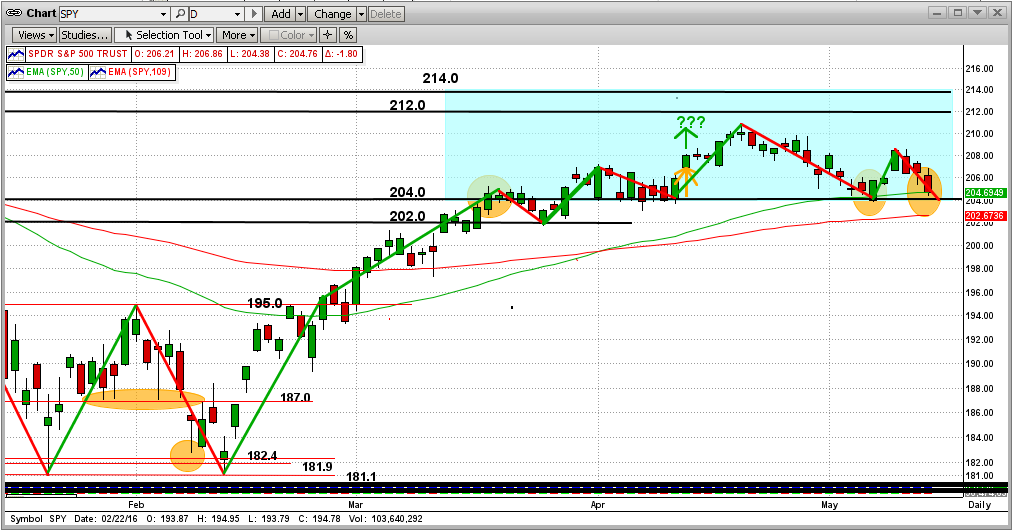
LONG TERM...
At this time, after a 7-year Bull Market, it is interesting and prudent to start analyzing the longer-term outlook. Consider this ...
There are thousands of things that make the stock market move up and down all day long (daily cycles). And, there are others that affect what the market does on a longer-term basis; such as on daily-weekly cycles (short-term), monthly-quarterly cycles (intermediate-term), and annual cycles (long-term).
"Things" that affect short and intermediate-term cycles, (fundamental and technical) are overwhelming, such as:
- natural disasters (earthquakes, tsunamis, etc.)
- terrorist attacks
- foreign crisis (Greece, China, etc)
- tech leader failure (Apple, Amazon, etc.)
- economic growth
- consumer prices
- inflation
- stock values (extreme P/E ratios)
- companies earnings/profits
- Fed Action
- interest rates
- quantitative easing
- dangerously low oil prices
- sentiment
- etc., etc., etc.
Short/Intermediate Term
The above are impossible to predict, but the impact on the market from "all of the above" combined can be measured and analyzed on an intermediate-term basis. That is what MIPS does for us. MIPS uses applied mathematics, pattern recognition, artificial intelligence, and common sense to tell us if the intermediate-term trend is moving up or down. Furthermore, each decision is analyzed in light of what MIPS sees the "big guys" doing (that is, institutional investors, like Morgan Stanley, Goldman Sachs, etc.). MIPS does this by "weighting" market changes by trading volume, using our proprietary "volume-weighted data". Basically, this means that market changes on high volume have a greater impact on decision than market changes on low volume. Of course, since high volume can only come from the big guys, we are basically tracking what the big guys are doing (high volume is like their "foot prints" in the sand).
Long-Term
The long-term trend should be a little easier to predict because of one single indicator. This indicator is NOT a technical indicator. Rather, it is a core fundamental fact which always shows which way the market should/will be moving. I say "should" because it sometimes takes a while to "sink in" (lag); and I say "will" because the market WILL ultimately follow this indicator.
Of course, this is not something that I made up or discovered. Big, smart investors like Warren Buffett have followed this fundamental indicator throughout their entire careers. It's not a new one either, as it was emphasized in Benjamin Graham's book "The Intelligent Investor" in 1949. This non-magical indicator is companies' PROFITS.
Ultimately, the long-term trend in stock prices is driven almost 100% by profits, but sometimes with a few months lag. [I believe that stock prices start moving up or dropping a few months before profits move up or down because the fat kats (CEOs, top management, board members, institutional investors, etc.) know in advance what direction their companies' quarterly profits will be, and they (and their family/friends) take action long before the profits are released to the public.]
Note: MIPS does not get "fooled" by the lag mentioned above and has called (and should continue to call) the drops/recoveries long before a single indicator like PRICE would. In 2008, MIPS was up over 50% !!!
See the graph below (from StockCharts.com and www.RealInvestmentAdvice.com)

BEWARE
In the graph above, you can see that PROFITS "peaked" at the end of 2015, and have been DROPPING for over 1 year now. I believe that the Fed, and only the Fed, has been keeping stock prices high throughout 2015 with quantitative easing and extremely low interest rates. This is not good and cannot continue to happen forever. When the Fed's "tricks" no longer have a positive impact on stock prices, and if the US economy does not improved significantly, we will most likely have a drop in the stock market like in 2000 and 2008 (see graph below).
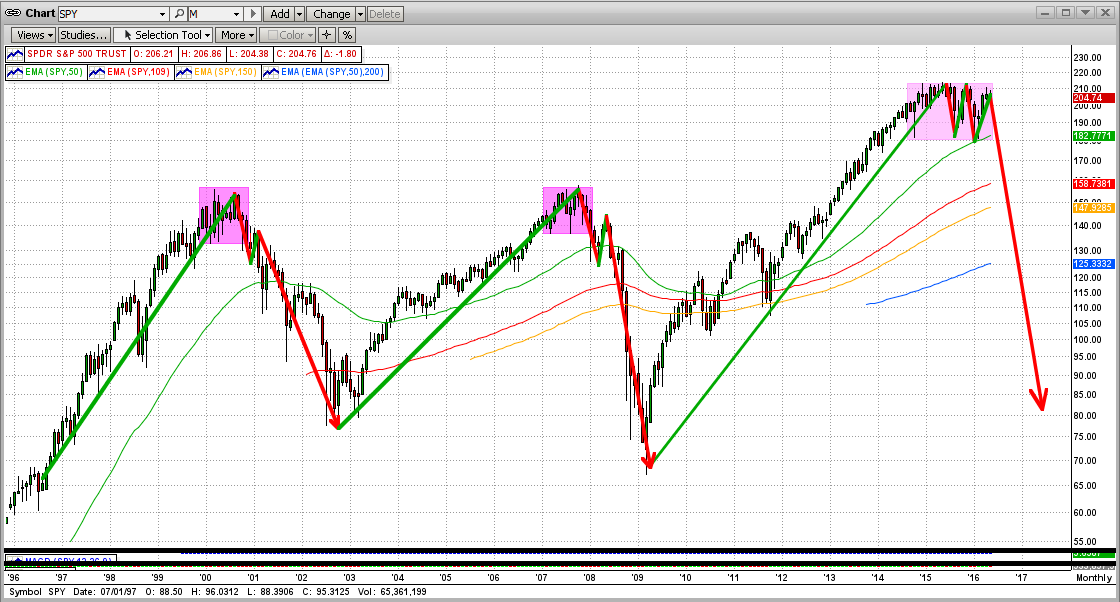
Good trading ...
Sunday, May 15 2016
We are all wondering where this market will go from here. On Friday of last week, the SPY closed very near a critical point - almost right on the 204.0 support level and dead-on the 50-day EMA (green line in graph below). Of course, in the short-term, the market can move either way from here. We will rely on MIPS to tell us how to trade this market now.

LONG TERM...
At this time, after a 7-year Bull Market, it is interesting and prudent to start analyzing the longer-term outlook. Consider this ...
There are thousands of things that make the stock market move up and down all day long (daily cycles). And, there are others that affect what the market does on a longer-term basis; such as on daily-weekly cycles (short-term), monthly-quarterly cycles (intermediate-term), and annual cycles (long-term).
"Things" that affect short and intermediate-term cycles, (fundamental and technical) are overwhelming, such as:
- natural disasters (earthquakes, tsunamies, etc.)
- terrorist attacks
- foreign crisis (Greece, China, etc.)
- tech leader failure (Apple, Amazon, etc.)
- economic growth
- consumer prices
- inflation
- stock values (extreme P/E ratios)
- companies earnings/profits
- Fed Action
- interest rates
- quantitative easing
- dangerously low oil prices
- sentiment
- etc., etc., etc.
Short/Intermediate Term
The above are impossible to predict, but the impact on the market from "all of the above" combined can be measured and analyzed on an intermediate-term basis. That is what MIPS does for us. MIPS uses applied mathematics, pattern recognition, artificial intelligence, and common sense to tell us if the intermediate-term trend is moving up or down. Furthermore, each decision is analyzed in light of what MIPS sees the "big guys" doing (that is, institutional investors, like Morgan Stanley, Goldman Sachs, etc.). MIPS does this by "weighting" market changes by trading volume, using our proprietary "volume-weighted data". Basically, this means that market changes on high volume have a greater impact on decision than market changes on low volume. Of course, since high volume can only come from the big guys, we are basically tracking what the big guys are doing (high volume is like their "foot prints" in the sand).
Long-Term
The long-term trend should be a little easier to predict because of one single indicator. This indicator is NOT a technical indicator. Rather, it is a core fundamental fact which always shows which way the market should/will be moving. I say "should" because it sometimes takes a while to "sink in" (lag); and I say "will" because the market WILL ultimately follow this indicator.
Of course, this is not something that I made up or discovered. Big, smart investors like Warren Buffett have followed this fundamental indicator throughout their entire careers. It's not a new one either, as it was emphasized in Benjamin Graham's book "The Intelligent Investor" in 1949. This non-magical indicator is companies' PROFITS.
Ultimately, the long-term trend in stock prices is driven almost 100% by profits, but sometimes with a few months lag. [I believe that stock prices start moving up or dropping a few months before profits move up or down because the fat kats (CEOs, top management, board members, institutional investors, etc.) know in advance what direction their companies' quarterly profits will be, and they (and their family/friends) take action long before the profits are released to the public.]
See the graph below (from StockCharts.com and www.RealInvestmentAdvice.com)

BEWARE
In the graph above, you can see that PROFITS "peaked" at the end of 2015, and have been DROPPING for over 1 year now. I believe that the Fed, and only the Fed, has been keeping stock prices high throughout 2015 with quantitative easing and extremely low interest rates. This is not good and cannot continue to happen forever. When the Fed's "tricks" no longer have a positive impact on stock prices, and if the US economy does not improved significantly, we will most likely have a drop in the stock market like in 2000 and 2008 (see graph below).

Good trading ...
Sunday, May 08 2016
MIPS Members:
Just as it appeared that the Bulls had broken out to the upside on 4/13/2016 to win the "Resistance Battle" of the SPY at 204.0, the Bears came back strong. The Bulls carried the SPY up to the 211.0 level, but the Bears pushed them back again to test 204.0.
The Bulls fought hard and held above the very strong 204 Resistance Level, which happened to also be the 50-Day EMA. This was a VERY bullish day !
Does this mean the market will be up from here? Absolutely not. It does mean, however, that the Bulls did find the strength to momentarily resist the downward push from the Bears when the market hit the ultra-critical 204.0 resistance.
This market could go either way from here (lots of good reasons now for both directions).
Let's wait for MIPS to tell us what to do !!!
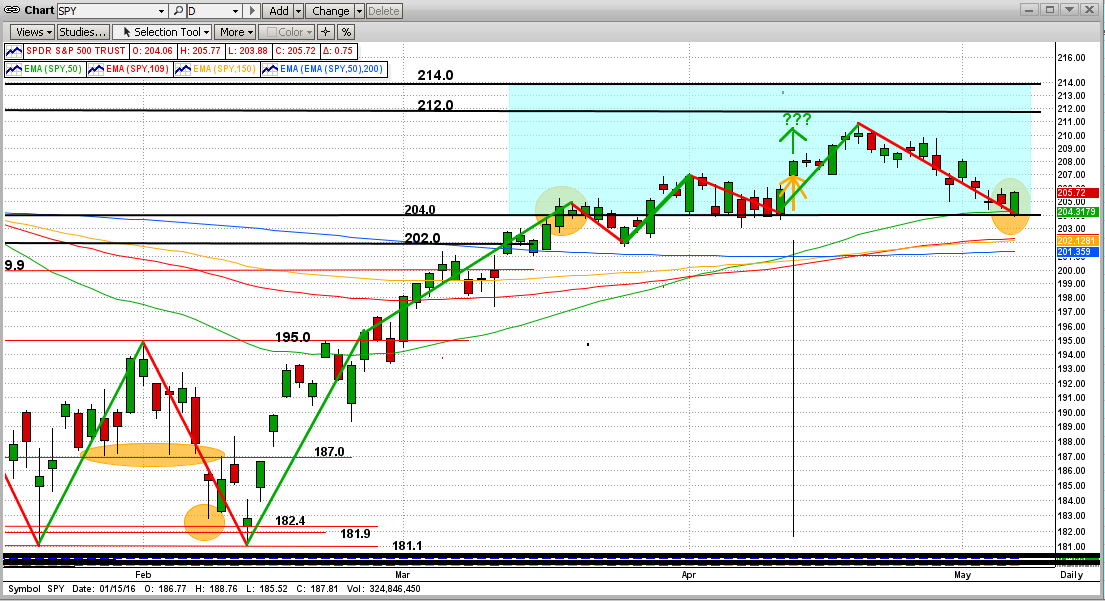
Wednesday, April 13 2016
Did we see the Bulls blast out to the upside today ?
- New run to at least to 212.0 or 214.0 ???
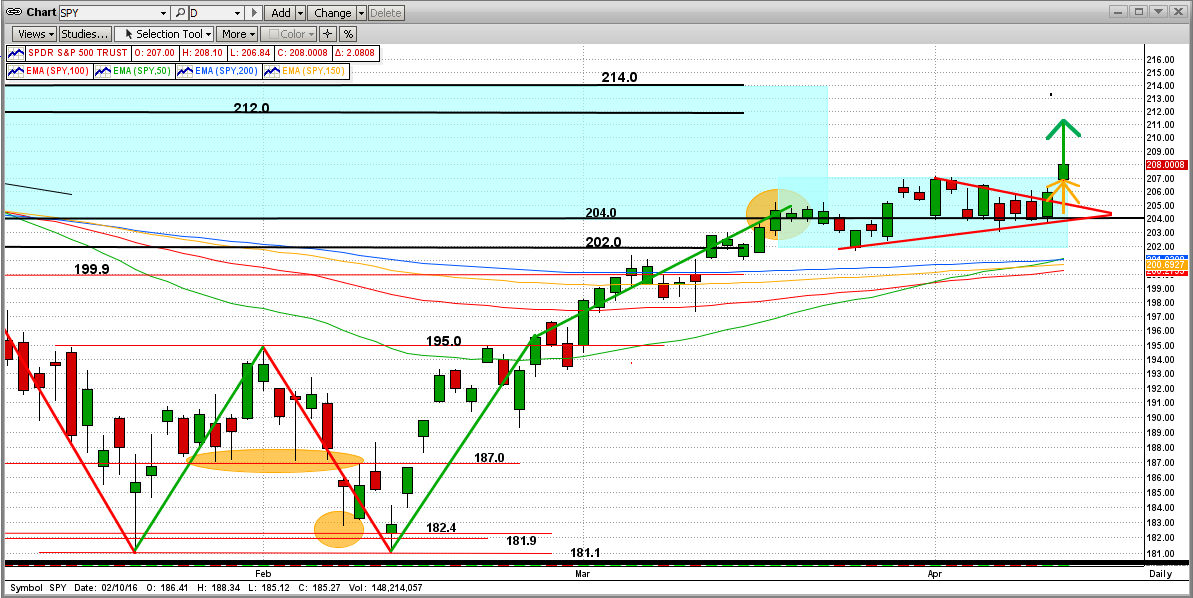
Monday, April 04 2016
Where do we go from here?
The SPY is sitting close to 204, up from about 181. The Bears want to push the SPY back down to 181, but the Bulls want it to continue up to the all-time-high resistance level at 214. When the SPY hit 204, it was like hitting a triple-reinforced brick wall (with lots of waffling around since then). "The Battle of 204" will turn out to be quite a battle.
Lots of people are simply peeking over the fence (watching) to see what might happen next, but MIPS is "in the gears" analyzing (calculating) what is most likely to happen next. I'm betting on MIPS !!!
PEEKING...

MIPS'ing...
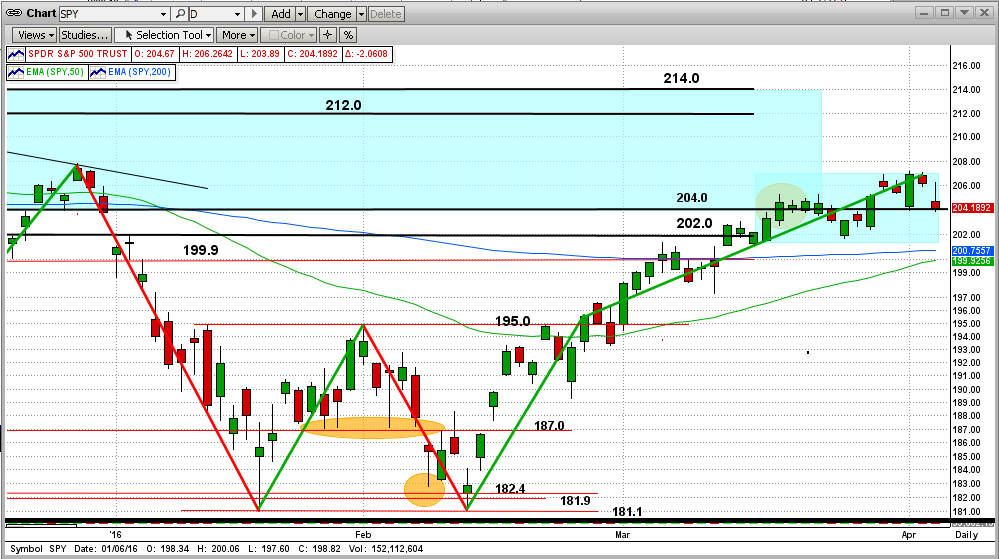
Sunday, April 03 2016
Rightfully so, many MIPS members are concerned about curve fitting, data mining, etc., in timing models on the market today (and, or course, in the MIPS models themselves). I can tell you point blank that we do not curve fit in the development of the MIPS models. I can also say with a high degree of certainly that any engineer with an advanced degree from a good school who has written software for control systems (say for nuclear power plants, space rockets, fighter jets, commercial aircraft, etc.), where failure is expensive or disastrous, knows the difference between curve fitting and the development of new algorithms to improve their software's performance.
I say "rightfully so" above, because many (or most) model developers do curve fit in the "development" of their models (if you want to call it "development"). The problem is that "curve fitting" is not really "development". It is merely forcing a bad model to look good using a certain set of data. And yes, done correctly, that model may produce good results after curve fitting with a certain set of data, but will almost certainly fail with any other set of data. I can also tell you that I know several model "developers" that curve fit in some form or fashion in their models, and they don't even know that they are doing so.
In reality, there can be a fine line between:
(1) curve fitting an existing model to perform better or
(2) introducing new algorithms to make a revised model perform better than its predecessor.
Let's see if I can come up with an example of this. In many cases, trying to come up with an example to explain something is more complicated than describing the original.
Allow me to try to explain fixing a fighter jet's control system software to better adhere to the design specs as to how fast the jet should climb in relation to how far back the pilot pulls "the stick". In any decent software of this type, the formula would be based on the physical fact that, because of the curvature of the top of the wing compared to the flat bottom, the air traveling over the top of the wing goes faster than that along the bottom, and hence the air pressure on the top of the wing is lower than that on the bottom. This pressure difference, of course, is what "pushes" the jet up into the lower pressure zone. This is why the wing is designed and built the way it is.
Now, let's say the fighter jet isn't working the way is should and two teams set out to fix it. Team #1 applies curve fitting and team #2 chooses to redesign.
Team #1
Curve fitting in this case could be "developers" tweaking certain parameters in the existing formula to force the jet to climb at a certain rate depending upon the speed of the jet. They may make this one jet perform better, but their "design" will likely fail for all others.
Team #2
Real development in this control system software would be where the design engineers that developed the formulas for how fast the wind over the wing should travel, realize that these formulas were developed for Mach1 speeds, but the current jets travel at Mach3. They also know that, at Mach3, the faster wind speed heats up the air going over the wing more than Mach1, and this hotter air get "lighter" (lower pressure). So, lighter air on the top makes the pressure from the bottom more effective, and the jet moves up faster.
Therefore, rather than one-time random "adjustments" which are also unexplainable from Team #1 (the curve fitters), the "real" design engineers in Team #2 introduced new mathematical algorithms that take the speed of the jet into consideration and adjust accordingly and automatically, and the software then works again at all speeds.
The main difference between these two approaches, of course, is that, when the software controlling of the jet needs to be improved:
Team #1 members "need and use" the raw data to adjust/develop their model, whereas
Team #2 members introduce new mathematical algorithms to closer resemble the performance of the jet itself (and they use the data
only to "prove" that the new algorithms/equations did improve the performance of the jet in the way in which it was designed).
Is this understandable?
Saturday, April 02 2016
GREAT NEWS FOR MIPS MEMBERS !!!
We have spent the last 15 months developing what has turned out to be some of the very best models on the market today. We call this version of our models the "Blaster Series". Even though we added many new algorithms that would make our models better, the main contribution is how we now handle "flat markets" (aka, sideways trading patterns, consolidation patterns, etc.). Call them what you will, but they wreak havoc on all types of timing models; partially because they are "trendless" and partially because these types of markets can change direction so frequently (every few days), that timing models available on the market today usually get whipsawed when trying to follow these patterns.
Therefore, we added new code in our MIPS models to successfully deal with:
(a) low volatility markets that "wiggle" either in a flat or very slow growing/degrading trend (2005),
(b) high volatility markets that shoot up/down in big cycles, and end up where they started (2011),
(c) high volatility markets that trade in a "very tight trading range" of plus/minus 3-5% and change
direction very frequently (like every 4-7 days, as in the first 8 months of 2015).
The results are a developer's dream:
Our tests of the new models show that, compared to the performance when we started developing this new series,
1) the CAGR of the Blaster models are 30-50% higher,
2) the Maximum Drawdowns have been reduced by about 35%, and
3) the average number of annual trades are about the same as, or a little less than, before.
Nomenclature:
Below are the names that we will use going forward to distinguish between the new MIPS "Blaster Series" models and the names of the prior models from which they came.
Pre-Blaster Models Blaster Models
MIPS1 No new model
MIPS2 MIPS22
MIPS3 MIPS33
MIPS4 MIPS44
MIPS/Nitro MIPS/Nitro5
Blaster Performance:
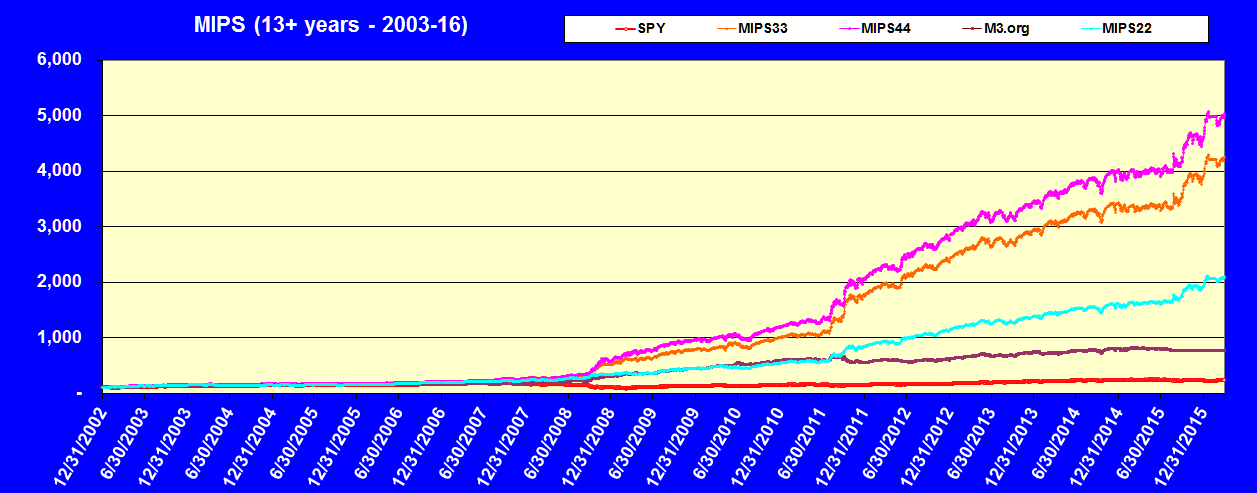
Tuesday, March 22 2016
Many of our MIPS followers (including me) are asking if we will see new highs on the S&P 500 in the near future. We believe there is a good chance of that happening, but we are at a very critial point now.
As you can see in the graph below, the SPY broke through the top of an obvious double bottom at 195.0 (SP500 1950) in early March 2016, and then climbed rapidly to the bottom of the 12-month flat channel from 2015 at 204.0 (SP500 2040). The "area" between SPY 204.0 and 214.0 is what we have been calling "No Man's Land". The SPY broke through 204.0 with force (orange elispe), and has "stagnated" close to there for the last 3 trading days. It is very bullish that the SPY has been able to close above 204.0 every day after either opening or dropping below 204.0 intraday. Good "bounce-backs" for the bulls !!![Looks like someone hanging on to the top of a fence for their life, and it may be so for some of their investing lives.]
It will be very difficult for the bulls to push the SPY all of the way through "no man's land", up to strong resistance levels at 212.0 and 214.0 (SP500 2120 and 2140). The SPY all time high is at 213.5 (SP500 2135). And, of course, it will be even harder for the bulls to push the SPY through that level. Even if that does happen, none of this is really good for us unless the SPY keeps going up from there or we get out before the fall back. Read on...

Alternate:
If the bulls cannot push through SPY 213.5, we may be back to the topping process and the possibility of a big drop from near the all-time high. See below.
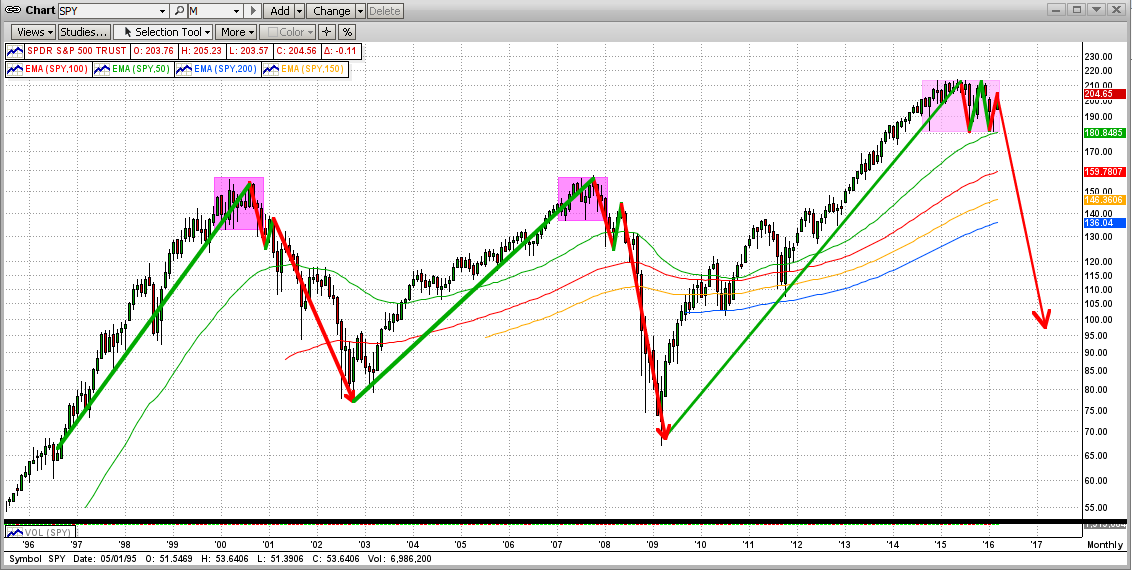
We will wait for MIPS to tell us how to trade this market...
|